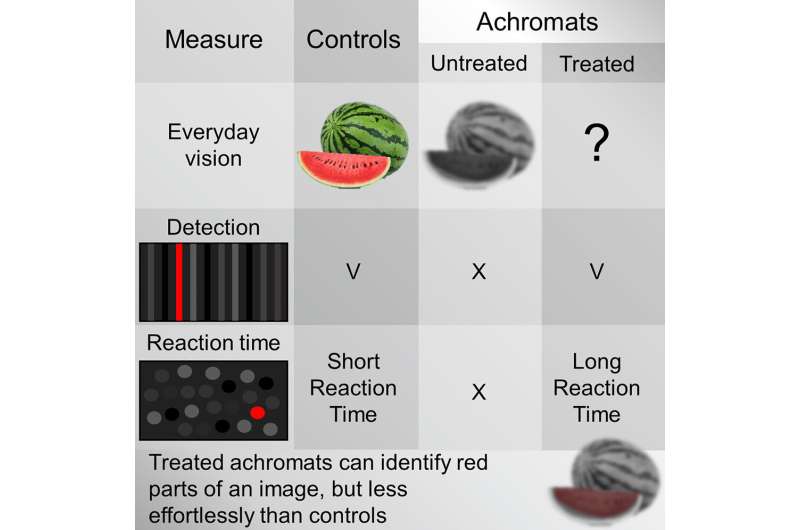July 18, 2023 report
This article has been reviewed according to Science X's editorial process and policies. Editors have highlighted the following attributes while ensuring the content's credibility:
fact-checked
peer-reviewed publication
trusted source
proofread
Gene therapy to restore color vision in complete achromatopsia patients shows modest improvement

Researchers at the Hebrew University of Jerusalem, Israel, have attempted to restore color vision to completely color-blind subjects using gene therapy. In their paper, "Seeing color following gene augmentation therapy in Achromatopsia," published in Current Biology, the team details the approach's success and limitations on achromatopsia patients lacking a functioning CNGA3 gene.
Following gene augmentation therapy to deliver an intact copy of the CNGA3 gene (cone-specific opsin promoter) to one eye, all four subjects reported seeing specific visual stimuli differently than before treatment. While technically still color blind, the augmented vision allowed patients to perceive "red," or at least the long wavelength of red color, separately and distinctly from their previous vision capability.
Color blindness has many causes, varying in severity depending on the underlying cause. While some can have color vision largely restored with the use of wavelength-separating glasses, correcting a condition where cones overlap in wavelength perception, others lack functioning cones entirely. Cones are what provide color vision and bright light vision, while rods provide grayscale vision for low-light applications.
Achromatopsia is a rare hereditary visual disorder affecting approximately 1 in 30,000 individuals, characterized by the absence of color vision, decreased vision, light sensitivity, and nystagmus (rapid eye movements). Unlike typical color blindness, achromatopsia involves more severe visual symptoms and a complete lack of functioning cones. It is present from birth and does not worsen over time.
Mutations in one of six genes cause achromatopsia. These mutations disrupt the normal functioning of cones in the retina, impairing color vision. The condition also affects visual acuity, and most achromatopsia patients have an average visual acuity of 20/200, which is classified as legal blindness.
There are two types of achromatopsia—complete and incomplete. In the complete type, no functional cones are present in the retina, leading to more severe visual symptoms. In the incomplete type, some cones remain functional, resulting in milder symptoms than in the complete type.
The achromatopsia patients treated in the current study have complete achromatopsia caused by the lack of a functioning CNGA3 gene which is critical to cone photoreceptor function. In restoring the gene, the researchers hoped to restore the functionality of the cones.
After treatment, the patients did not experience a shift to color vision, though they did see differently than before. Color detection, to some degree, was evident in the treated eyes of all patients, with the red stimulus being the most detectable. This detection was slow, requiring focused attention and was far below the level observed in individuals with normal color vision.
What would seeing a new color for the first time look like?
Patients struggled to find appropriate words to describe their perception of the red stimulus, stating that it glows differently, shines, or appears on a different plane than the background. A lack of change in perceived color lightness and the ability to detect the color cues when lightness cues were eliminated suggests that lightness is not a major component of the color perception reported by patients.
The authors speculate that the patients' rods may continue to function under photopic conditions even after treatment, overriding the cone-derived signal and preventing the emergence of a full-color sensation.
Functional and structural differences in the visual cortex and morphological changes resulting from the long deprivation of chromatic signals may also contribute to the incomplete recovery of color perception. Testing was conducted 1–3 years after treatment with little sign of brain plasticity taking on additional color perception processing.
While the improvement was limited, it is an improvement. It also indicates additional factors beyond the direct genetic component that can be isolated and studied to create a more complete treatment. As with any good research result, further research is needed.
More information: Ayelet McKyton et al, Seeing color following gene augmentation therapy in achromatopsia, Current Biology (2023). DOI: 10.1016/j.cub.2023.06.041
© 2023 Science X Network


















